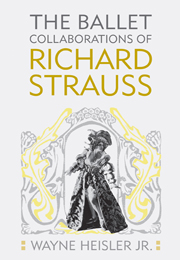Book contents
- Frontmatter
- Contents
- List of Illustrations
- Acknowledgments
- Introduction: Richard Strauss, Dance, and Ballet
- Part One Becoming a Ballet Composer, 1895–1914
- 1 Strauss en route to Die Insel Kythere (The Isle of Cythera, 1900)
- 2 Josephslegende (The Legend of Joseph, 1914), Léonide Massine, and the Music Box Dancer
- Part Two “To drive away all cloudy thoughts,” 1919–1941
- Epilogue
- Notes
- Works Cited and Consulted
- Index
- Eastman Studies in Music
1 - Strauss en route to Die Insel Kythere (The Isle of Cythera, 1900)
from Part One - Becoming a Ballet Composer, 1895–1914
Published online by Cambridge University Press: 12 September 2012
- Frontmatter
- Contents
- List of Illustrations
- Acknowledgments
- Introduction: Richard Strauss, Dance, and Ballet
- Part One Becoming a Ballet Composer, 1895–1914
- 1 Strauss en route to Die Insel Kythere (The Isle of Cythera, 1900)
- 2 Josephslegende (The Legend of Joseph, 1914), Léonide Massine, and the Music Box Dancer
- Part Two “To drive away all cloudy thoughts,” 1919–1941
- Epilogue
- Notes
- Works Cited and Consulted
- Index
- Eastman Studies in Music
Summary
[Strauss] says he has only composed some small things since last year. He says, smiling as he does so, that he thinks he is suffering from senile decay.—He wants to write a ballet.
—Romain Rolland, diary, March 1, 1900In 1959, the musicologist Willi Schuh published Richard Strauss's scenario and fragmentary musical sketches for Die Insel Kythere (The Isle of Cythera). The inspiration for this unfinished ballet occurred during the composer's trip in early 1900 to Paris to conduct two concerts. While in the French capital, Strauss also visited its cultural landmarks, including the Louvre, where he took interest in the French rococo, especially canvases by Jean-Antoine Watteau (1684–1721). As he had done for his only complete opera to date, Guntram (1894), Strauss himself drafted the three-act libretto to Die Insel Kythere, which remains obscure despite its posthumous publication.
As the curtain opens on Kythere's first act, labeled “Watteau,” the peasant residents of the island return from a day of working in the fields. Supplementing the act heading “Watteau,” Strauss noted “Teniers” in the margin of this scene, referring to one of the painters from the family of seventeenth-century Flemish artists. Thus, the Cythera peasants' happy-hour dancing was modeled on an image such as Fête villageoise avec couple aristocratique (Rural Festival with Aristocratic Couple, 1652)—albeit without the aristocracy at this point in Strauss's narrative—by David Teniers the Younger (a.k.a. David Teniers II, 1610–90), part of the Louvre's collection since 1794 (see figure 1.1). The native islanders depart.
- Type
- Chapter
- Information
- The Ballet Collaborations of Richard Strauss , pp. 13 - 45Publisher: Boydell & BrewerPrint publication year: 2009

